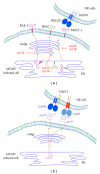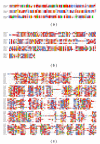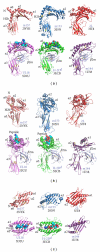How the virus outsmarts the host: function and structure of cytomegalovirus MHC-I-like molecules in the evasion of natural killer cell surveillance
- PMID: 21765638
- PMCID: PMC3134397
- DOI: 10.1155/2011/724607
How the virus outsmarts the host: function and structure of cytomegalovirus MHC-I-like molecules in the evasion of natural killer cell surveillance
Abstract
Natural killer (NK) cells provide an initial host immune response to infection by many viral pathogens. Consequently, the viruses have evolved mechanisms to attenuate the host response, leading to improved viral fitness. One mechanism employed by members of the β-herpesvirus family, which includes the cytomegaloviruses, is to modulate the expression of cell surface ligands recognized by NK cell activation molecules. A novel set of cytomegalovirus (CMV) genes, exemplified by the mouse m145 family, encode molecules that have structural and functional features similar to those of host major histocompatibility-encoded (MHC) class I molecules, some of which are known to contribute to immune evasion. In this review, we explore the function, structure, and evolution of MHC-I-like molecules of the CMVs and speculate on the dynamic development of novel immunoevasive functions based on the MHC-I protein fold.
Figures



Similar articles
-
Mouse Cytomegalovirus m153 Protein Stabilizes Expression of the Inhibitory NKR-P1B Ligand Clr-b.J Virol. 2019 Dec 12;94(1):e01220-19. doi: 10.1128/JVI.01220-19. Print 2019 Dec 12. J Virol. 2019. PMID: 31597762 Free PMC article.
-
Inhibition of natural killer cells by a cytomegalovirus MHC class I homologue in vivo.Nature. 1997 Apr 3;386(6624):510-4. doi: 10.1038/386510a0. Nature. 1997. PMID: 9087412
-
Immune escape and exploitation strategies of cytomegaloviruses: impact on and imitation of the major histocompatibility system.Cell Microbiol. 2004 Aug;6(8):707-17. doi: 10.1111/j.1462-5822.2004.00425.x. Cell Microbiol. 2004. PMID: 15236638 Review.
-
Human cytomegalovirus glycoprotein UL16 causes intracellular sequestration of NKG2D ligands, protecting against natural killer cell cytotoxicity.J Exp Med. 2003 Jun 2;197(11):1427-39. doi: 10.1084/jem.20022059. J Exp Med. 2003. PMID: 12782710 Free PMC article.
-
Host-Adapted Gene Families Involved in Murine Cytomegalovirus Immune Evasion.Viruses. 2022 Jan 11;14(1):128. doi: 10.3390/v14010128. Viruses. 2022. PMID: 35062332 Free PMC article. Review.
Cited by
-
Modulation of innate and adaptive immunity by cytomegaloviruses.Nat Rev Immunol. 2020 Feb;20(2):113-127. doi: 10.1038/s41577-019-0225-5. Epub 2019 Oct 30. Nat Rev Immunol. 2020. PMID: 31666730 Review.
-
MCMV avoidance of recognition and control by NK cells.Semin Immunopathol. 2014 Nov;36(6):641-50. doi: 10.1007/s00281-014-0441-9. Epub 2014 Aug 21. Semin Immunopathol. 2014. PMID: 25141793 Review.
-
Recognition of Self and Viral Ligands by NK Cell Receptors.Immunol Rev. 2025 Jan;329(1):e13435. doi: 10.1111/imr.13435. Immunol Rev. 2025. PMID: 39748148 Free PMC article. Review.
-
Functional annotation of human cytomegalovirus gene products: an update.Front Microbiol. 2014 May 19;5:218. doi: 10.3389/fmicb.2014.00218. eCollection 2014. Front Microbiol. 2014. PMID: 24904534 Free PMC article. Review.
-
Identification of the predominant human NK cell effector subset mediating ADCC against HIV-infected targets coated with BNAbs or plasma from PLWH.Eur J Immunol. 2021 Aug;51(8):2051-2061. doi: 10.1002/eji.202149188. Epub 2021 Jun 19. Eur J Immunol. 2021. PMID: 34086344 Free PMC article.
References
-
- Reddehase MJ. Antigens and immunoevasins: opponents in cytomegalovirus immune surveillance. Nature Reviews Immunology. 2002;2(11):831–844. - PubMed
-
- McGeoch DJ, Cook S, Dolan A, Jamieson FE, Telford EAR. Molecular phylogeny and evolutionary timescale for the family of mammalian herpesviruses. Journal of Molecular Biology. 1995;247(3):443–458. - PubMed
-
- Hengel H, Reusch U, Gutermann A, et al. Cytomegaloviral control of MHC class I function in the mouse. Immunological Reviews. 1999;168:167–176. - PubMed
-
- London WT, Martinez AJ, Houff SA. Experimental congenital disease with simian cytomegalovirus in rhesus monkeys. Teratology. 1986;33(3):323–331. - PubMed
Publication types
MeSH terms
Substances
Grants and funding
LinkOut - more resources
Full Text Sources
Research Materials
